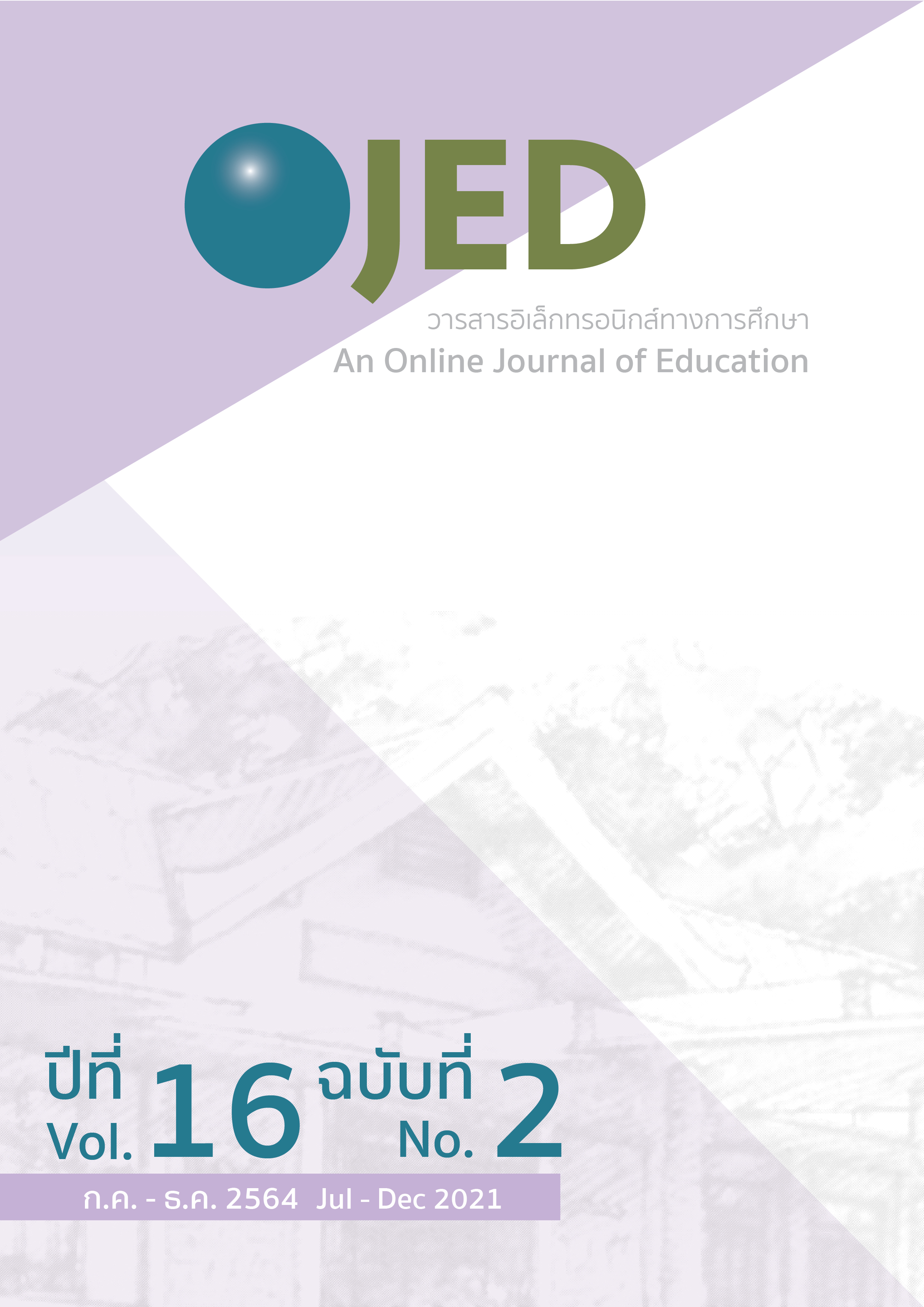Development of 5E Instructional Model on Mobile Learning Technology to Enhance Reasoning Ability of Lower Primary School Students
DOI:
https://doi.org/10.14456/ojed.2021.47Keywords:
mobile learning technology, 5E instructional model, reasoning abilityAbstract
The purpose of this research study was to develop a model of 5E instructional model on mobile learning technology to enhance reasoning ability of lower primary school students. The sample for the survey consisted of eight experts in the field of educational technology and mobile learning, scientific method experts and reasoning ability method experts. The research instruments consisted of the expert interview form and the model evaluation form. The result of this study was the model comprised of five elements and five steps. The five elements were: (1) M-Learning Systems; (2) Applications; (3) Capture; (4) Contents; (5) Communications. The five steps were: (1) Engagement; (2) Exploration; (3) Explanation; (4) Elaboration; (5) Evaluation.
References
ธงชัย แก้วกิริยา. (2553). E-Learning ก้าวไปสู่ M-Learning ในยุคสังคมของการสื่อสารไร้พรมแดน. วารสารร่มพฤกษ์, 28(1).
นวลจิตต์ เชาวกีรติพงศ์. (2552). การจัดการเรียนการสอนแบบสืบเสาะหาความรู้ Inquiry-based learning. http://www.lic.chula.ac.th/web/mediaflash/Inquiry/Inquiry/index.html
พรเทพ จันทราอุกฤษฎ์. (2556). การพัฒนารูปแบบการเรียนการสอนโดยบูรณาการรูปแบบการสืบสอบแบบโต้แย้งและแนวคิดการเรียนรู้โดยใช้แบบจำลองเป็นฐานเพื่อเสริมสร้างสมรรถนะการรู้วิทยาศาสตร์และความมีเหตุผลของนักเรียนมัธยมศึกษาตอนต้น [วิทยานิพนธ์ปริญญาดุษฎีบัณฑิต, จุฬาลงกรณ์มหาวิทยาลัย]. Chulalongkorn University Intellectual Repository (CUIR). https://www.car.chula.ac.th/display7.php?bib=b2052464
พิมพันธ์ เดชะคุปต์. (2544). การเรียนการสอนที่เน้นผุ้เรียนเป็นสำคัญ แนวคิด วิธีและเทคนิคการสอน. เดอะมาสเตอร์กรุ๊ป แมเนจเม้นท์.
พิมพันธ์ เดชะคุปต์ และ พเยาว์ ยินดีสุข. (2548). วิธีวิทยาการสอนวิทยาศาสตร์ทั่วไป. สำนักพิมพ์พัฒนาคุณภาพวิชาการ (พว.).
ไพฑูรย์ ศรีฟ้า. (2555, 22 กรกฎาคม). แท็บเล็ตกับการจัดการศึกษาในยุคศตวรรษที่ 21. ACADEMIA. https://www.academia.edu/7198048/แท็บเล็ตกับการจัดการศึกษาในยุคศตวรรษที่_21
วิจารณ์ พานิช. (2556). วิถีการเรียนรู้เพื่อศิษย์ในศตวรรษที่ 21. มูลนิธิสดศรี-สฤษดิ์วงศ์.
วิชัย เสวกงาม. (2557, 7 สิงหาคม). Teachers as Learners ห้องพักครู: ความสามารถในการใช้เหตุผล. TEACHERS as LEARNERS. https://www.youtube.com/watch?v=mm7oD-reM2M
สถาบันส่งเสริมการสอนวิทยาศาสตร์และเทคโนโลยี. (2546). คู่มือวัดและประเมินผลวิทยาศาสตร์. สถาบันส่งเสริมการสอนวิทยาศาสตร์และเทคโนโลยี.
สถาบันส่งเสริมการสอนวิทยาศาสตร์และเทคโนโลยี. (2550). รูปแบบการเรียนการสอนที่พัฒนากระบวนการคิดระดับสูง วิชาชีววิทยา ระดับชั้นมัธยมศึกษาตอนปลาย. http://www.ipst.ac.th/biology/Bio-Articles/mag-content10.html
สำนักงานคณะกรรมการการศึกษาขั้นพื้นฐาน. (2555). คู่มืออบรมปฏิบัติการบูรณาการใช้คอมพิวเตอร์พกพา (Tablet) เพื่อยกระดับการเรียนการสอน. สำนักเทคโนโลยีเพื่อการเรียนการสอน.
สุรศักดิ์ ปาเฮ. (2556). M-learning เปิดโลกแห่งการเรียนรู้ด้วยเทคโนโลยีแบบพกพา. http://www.addkutec3.com/wp-content/uploads/2013/10/M-Learning-เปิดโลกความรู้.pdf
สุวิทย์ มูลคำ และ อรทัย มูลคำ. (2545). 21 วิธีจัดการเรียนรู้เพื่อพัฒนากระบวนการคิด. ดวงกมลสมัย.
Australian Academy of Science. (2012). Teaching primary science: Trial-teacher feedback on the implementation of primary connections and the 5E model. Australian government department of education.
Bybee, R. W., Taylor, J. A., Gardner, A., Scotter, P. V., Powell, J. C., Westbrook, A., & Landes, N. (2006, June 12). The BSCS 5E instructional model: Origins, effectiveness, and applications. BSCS SCIENCE LEARNING. https://media.bscs.org/bscsmw/5es/bscs_5e_full_report.pdf
Huang, Y. M., Liang, T. H., Su, Y. N., & Chen, N. S. (2012). Empowering personalized learning with an interactive e-book learning system for elementary school students. Educational Technology Research and Devel-opment, 60(4), 703-722. https://doi.org/10.1007/s11423e012e9237e6.
Hwang, G. J., Wu, P. H., & Ke, H. R. (2011). An interactive concept map approach to supporting mobile learning activities for natural science courses. Computers and Education, 57(4), 2272-2280. https://doi.org/ 10.1016/j.compedu.2011.06.011.
Joosten, T. (2010, June 11). Mobile learning and social media: Increasing engagement and interactivity. https://tinyurl.com/yb69e4fk
Keegan, D. (2002). Mobile Learning: A practical guide. http://tinyurl.com/yl2g8mjw
National Research Council. (2000). Inquiry and the national science education standards: A guide for teaching and learning. https://tinyurl.com/yce3rxpu.
Schofield, C. P., West, T., & Taylor, E. (2011). Going mobile in executive education: How mobile technologies and changing the executive learning landscape (Research for UNICORN). London, UK: Ashridge & UNICORN. https://tinyurl.com/y75xgjkc.
Downloads
Published
How to Cite
Issue
Section
License

This work is licensed under a Creative Commons Attribution-NonCommercial-NoDerivatives 4.0 International License.




